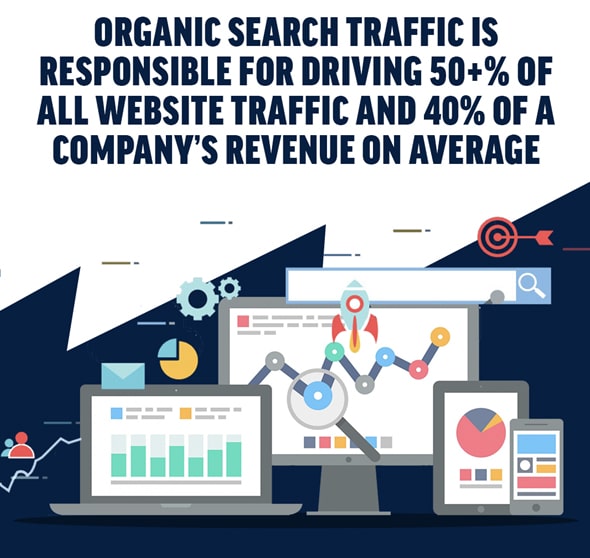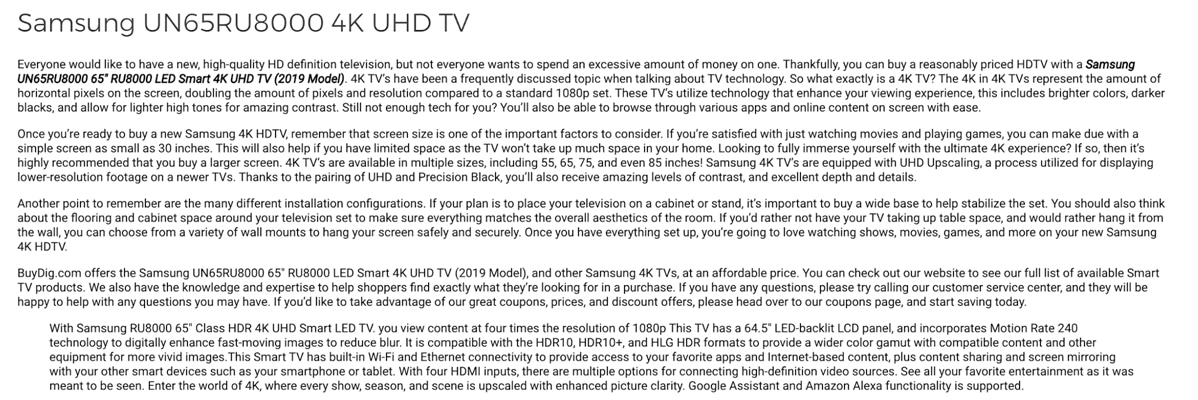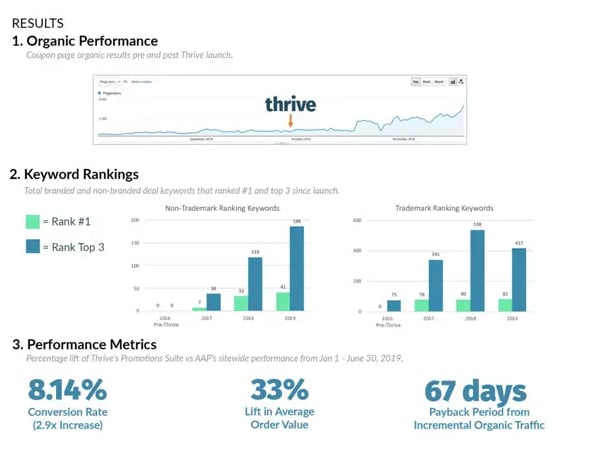As an eCommerce merchant, it’s very easy to get stuck focusing your digital marketing campaigns on channels like social media or email. And while these channels can certainly drive traffic and sales, SEO is still king. Organic search traffic is responsible for driving 50+% of all website traffic and 40% of a company’s revenue on average. Majority of marketers even report that organic search provides the highest ROI, even over PPC advertising.

The goal of SEO is to increase your web pages’ search engine rankings, aiming for the first page of the search engine results, as 75% of people never go past the first page. Ideally, you want to rank in the first three positions, because those positions have the highest click-through rate. Industry data shows that on average, the #1 search result on Google has a CTR of 31.73% while the second and third results have a CTR of 24.71% and 18.66% respectively. Unsurprisingly, CTRs diminish the lower you get on the search results page. The fourth search result has a CTR of just 13.6% and the succeeding search results get single-digit CTRs. So let’s talk about how you can do just that. Follow these retail SEO tips to help your ecommerce site hit the first page of the search engine results for the keywords you want to rank for.
1. Conduct keyword research to build your SEO strategy.
Keyword research is the foundation of all good SEO strategies. This step is all about figuring out what relevant keywords your various web pages should be ranking for so you can accurately optimize each of your pages to those keywords. Effective keyword research isn’t just about determining which keywords you should be ranking for, but also which ones provide the best opportunities. Certain keywords will have a huge amount of competition on them, while others will have less. Generally, the ones with less competition get less traffic, but if you can knit together several number one rankings on smaller keywords, it can often be just as effective. As a bonus, the less competitive keywords are often much more specific phrases, known as long-tail keywords. These long-tail keywords tend to have a much higher conversion rate, averaging 36%, according to Neil Patel. To perform keyword research, you’ll want to blend two techniques:
- See which search terms your pages are currently ranking for. These keywords will help you determine opportunities, as well as bringing up some keywords you may not have thought of. You can use a tool like Google Analytics or Google Search Console to discover which keywords you’re already ranking for.
- Use a keyword tool like Google Keyword Planner, Ahrefs, or SEMRush to discover related relevant keywords, as well as their monthly search volume and competitiveness.
- If you have a dedicated SEO team, there are enterprise SEO analytics platforms that can provide even more detailed metrics, analytics, and performance tracking. Thrive’s clients benefit from these powerful SEO tools through our partnership with Conductor, a company that offers an organic marketing platform along with digital strategic services for enterprises.
Once you’ve created a list of target keywords, you can optimize your pages and content marketing for them.
2. Optimize your product descriptions.
It’s important to get your keywords into your page copy, but it’s even more important to write your copy for humans, particularly when it comes to your product descriptions.
Product descriptions are an easy way to set your site apart from others to search crawlers. They’re also one of the main ingredients in getting visitors to stay on your site, rather than hopping back to the results page, which the algorithm sees as a huge mark in your favor. Google’s algorithm favors an excellent user experience. When users spend more time on your page and don’t hit the back button to look at other search results, Google sees that as a positive ranking signal, which may ultimately help improve your position in SERPs.
Search engine optimization tips for writing product descriptions:
- Write a unique description for each product. Duplicate content on your website or from other websites will always get you dinged by the algorithm, even when it’s high-quality content.
- Clayton Nichols, ecommerce SEO expert, recommends writing descriptions over between 300 and 500 words.
- Do utilize your keywords. If you can work them in naturally, they not only serve to tell the crawlers where to rank the page, but they act as a sign to visitors that they’ve found the page they were searching for.
A great example of well-optimized product descriptions can be found on BuyDig, an electronics and appliance e-tailer. In addition to being incredibly detailed and informative, their product descriptions include the keywords they’re targeting and are highly engaging pieces of copy that not only describe the product but describe how it fits into the customer’s life.

3. Optimize your structured data for ecommerce SEO
Structured data is essentially a set of data that doesn’t appear on your page, but provides a way for search engine crawlers to understand the page. The crawlers may also choose to pull some of your meta tagsto create the snippet for the results page. As a result, structured data plays an important role in both your rankings and your click-through rates.
Search engines can use structured data in rich snippets, which act as a preview of your page within the search results and can take a variety of forms.
In the realm of retail and ecommerce SEO, rich snippets can display product info, ratings and reviews, pricing, and more. The screenshot below shows structured data for Shoe Carnival’s coupon codes and offers.

With the right structure data, you may get featured as a rich snippet, which according to Moz, can increase your CTR from the SERP by 677%.
SEO tips for structured data:
- Be as specific, accurate, and complete as possible. It’s better to have fewer properties if they’re completed and accurate than to have all properties filled in partially.
- Use JSON-LD format if possible.
- Don’t bother providing structured data for your homepage as Google officially ignores it.
- If you’re not a coding expert, use Google’s Structured Data Markup Helper to get started.
4. Optimize your ecommerce site pages for mobile devices
Mobile optimization and page load speed are crucial, not only to improve your conversion rates but also to improve your SEO. Google’s algorithm favors websites that are optimized for mobile devices.

Having a quick load time is especially crucial for mobile users (although it shouldn’t be ignored for desktop users, either). The longer your load time, the higher your bounce rate. Research by Pingdom found that the average bounce rate for a page that loads within 2 seconds is 9%. The bounce rate increases for every second that a page loads, and it soars to 38% once a page’s load time hits 5 seconds.
You can use Google’s PageSpeed Insights Tool to get some ideas on how to improve your load speed. The tool scores you on both mobile and desktop and provides separate recommendations for both.

5. Target coupon-related keywords with multiple landing pages.
Coupon keywords are highly valuable. Why? For starters, branded discount keywords (e.g, “company name + coupon” or “company name + discount”) are almost always the number one branded search category for EVERY retail brand.
Clearly, shoppers are actively searching for product deals and brand discounts, and they’re using Google as their first stop when looking for promotions.
Consider the fact that billion-dollar company, RetailMeNot, makes most of its revenue from Google searches for coupon codes. Thrive clients also find that customers from these keywords have a higher conversion rate and often a higher average order value. Because the keywords have high search volumes and are so successful, they’re also highly competitive. Every online store in your space, as well as plenty of RetailMeNot competitors, are trying to rank for these keywords.
It should be noted that people will search for deals both specifically for your products (branded keywords) and more generally for your product types (non-branded keywords). That is, someone might search “Anna’s Bakery coupon codes” or “Cake coupon codes,” and Anna’s bakery wants to appear on both.
One strategy to succeed is to create a variety of landing pages meant to target these keywords separately. Take this list of keywords:
- Anna’s bakery coupon codes
- Cake coupon codes
- Anna’s bakery’s deals
- Cake deals
- Cheap cakes
- Anna’s bakery sale
Anna’s Bakery would then want to create a landing page for each of these keywords (some of them may work together, like the coupon codes keywords). Each landing page can then be optimized specifically for that keyword and related keywords, resulting in better rankings for the single keyword, rather than ok ratings across a few keywords.
6. Don’t forget about internal link building
We’ve all heard about backlinks and how they’re great for SEO. But did you know that internal links — i.e., links to the same domain — are also really important?
Ninja Outreach discovered that internal links boosted their organic traffic by a whopping 40%. The reason is that Google can only discover new pages when it follows a link from a known page to a new page. Thus, linking to the page somewhere else on your site tells Google to index the page.
Additionally, internal links help Google’s crawlers move around your site, figuring out which one of your pages are more important than others.
You can indicate a page’s authority to the crawlers by placing that page at the top of a content silo. A silo is when you have a hub page that’s linked into the rest of your website, and links out to other, less authoritative pages that only link back to the hub. The crawlers then understand that the hub page is the most important.
For ecommerce merchants, siloing often looks like using category pages as the hub page and product pages as the less authoritative pages.
You may need to limit the depth of your categories as a merchant. The more subcategories you have, the harder it will be for Google to determine which of your pages is the hub, resulting in poor ranking for all pages.
It’s also important to note that the internal links from your blog, sales pages, and header/footer not only create SEO equity, they also lead a better user experience. For instance, when our client Advance Auto Parts started linking their car battery promotions pages from their blog, that category page began ranking higher for keywords like “car battery coupons”.
See if you can implement a similar practice. Identify the pages that you want to rank on search results, then find internal opportunities within your site.
7. Update promotions pages frequently for fresh content
Content freshness is generally assumed to be an important part of Google’s algorithm. While product pages can easily add fresh content if you enable search engines to read your product reviews, many merchants overlook the importance of updating their promotions or coupon page.
Don’t make the same mistake. Regularly refresh the page’s content either manually or with an automatic solution like our Intelligent Promotions Solution, which Advance Auto Parts has used to great effect. It resulted in a huge lift in organic traffic within just a single month. By the end of 2019, three years after implementation, AAP was ranking in the top 3 for 196 non-branded search terms. They previously had not ranked in the top three at all.

8. Don’t remove discontinued and out of stock products
It is the nature of ecommerce that some products sell out or get discontinued. How your store handles those specific product pages is crucial to SEO. Removing the item from your site causes a 401 redirect that is neither a good customer experience nor a search engine friendly strategy.
Ways for online retailers to handle discontinued or out-of-stock products:
- Add a 301-redirect to a new page. The 301 simply forwards the visitor onto another page of your choosing. It has the added benefit of transferring your SEO over to a new page. 301s are a good idea for discontinued products. You can send the visitor to a similar item or a category page listing several similar items.
- Push the out-of-stock product to the bottom of your catalog and place an email form on it so visitors can be notified when the product is restocked.
- Place a clear label at the top of the page indicating that the product is discontinued or out-of-stock, and prominently display recommendations for similar products.
Conclusion
Organic search traffic is the lifeblood of many ecommerce retailers, especially as paid traffic becomes more and more competitive and expensive. However, with Google constantly making quiet changes to the algorithm, it takes a constantly creative mind to keep an ecommerce site’s web pages ranking well. A retail SEO expert must constantly be trying new things, like optimizing for local searches or trying new landing page content.

